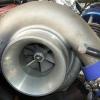Announcements
-
Similar Content
-
Latest Posts
-
Maybe? I have the Supercheap ToolPro low thingo. It has a somewhat smaller diameter lifting "bowl" than you would expect on a workshop grade trolley jack, and a split rubber pad to suit that diameter. It clears the "N1" style skirts I have. Probably wouldn't if the jack's bowl and a suitably larger rubber block were in use. Having said that though.....you only need the rubber block to exist on the inner side of the pinchweld, so could carve away any rubber that fouled the skirt, leaving some there for "insurance" </simples>
-
I used to do that (sills with rubber jack block).. ... then I got side skirts, and there's no way for the jack to actually work there, the jack pad itself on the jack is too big. Is the answer to use a... smaller (?) jack? Hmmm.
-
By Murray_Calavera · Posted
I have too much trauma from every skyline I've ever seen having crushed jack points/pinch welds lol. Yep, works 100%, it's what I use when I'm using the quick jack. Don't know why I can't also bring myself to do the same thing when I'm using a jack. I blame the skyline PTSD. -
The pinchweld is fine, even with a trolley jack, so long as you're not actually pushing on the pinchweld itself. More to the point, we shouldn't talk about lifting or supporting on the pinchweld, we should talk about using the sill "jacking points", which just happen to be adjacent to the pinchweld. I just have dense rubber blocks with grooves in them for each of the chassis stands and the trolley jack, that I use at the sill jacking points if/when I have to lift/support there. They put all the load onto the steel pad of the jacking point and not the pinchweld. As intended.
-
By Murray_Calavera · Posted
Makes sense. I would do something different if I felt like there was a better option. Generally the only other area I'm happy to jack on is where I want to put the stand. The pinch weld is not an option for me for either the jack or stands, so very limited options overall. Plus never having had an issue with doing this, has kinda reinforced in my mind that it's fine. I'd do it on any car without a second thought these days lol.
-






Recommended Posts
Create an account or sign in to comment
You need to be a member in order to leave a comment
Create an account
Sign up for a new account in our community. It's easy!
Register a new accountSign in
Already have an account? Sign in here.
Sign In Now